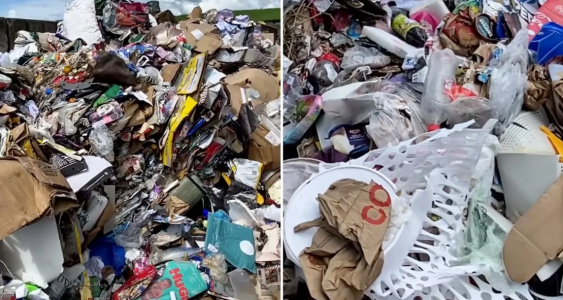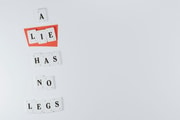Are you making this common recycling mistake that's sending all your efforts straight to landfill?
By
Gian T
- Replies 4
Recycling is one of those everyday habits that most of us take pride in—after all, who doesn’t want to do their bit for the environment? But did you know that a single slip-up in your yellow-lid bin could undo all your good intentions and send an entire truckload of recyclables straight to landfill?
That’s exactly what happened recently on the Cassowary Coast, just south of Cairns, and it’s a timely reminder for all of us to brush up on our recycling know-how.
One Wrong Move, Big Consequences
A shocking video shared by the Cassowary Coast Council showed a recycling truck’s entire load being dumped at a landfill, all because of a few wrongly placed items. Among the culprits? Plastic bags, food scraps, and other non-recyclables that had no business being in the yellow bin.
Councillor Ellen Jessup called the incident a 'shame', especially since the region had just switched from ‘wet waste’ and ‘dry waste’ bins to the more familiar red (general waste) and yellow (recycling) system. The change has left some residents scratching their heads about what goes where, and old habits—like bagging up recyclables—are proving hard to break.
'If we’re going to bag things and put them into the recycling bin, it’s contaminated from the start because the soft plastics cannot go into the recycling,' Cr Jessup explained. 'If we can educate people to put loose items in, such as cardboard, tins, bottles, those sorts of things, that’s a big outcome, and it cuts down the amount of soft plastics that shouldn’t be there.'
The Usual Suspects: What NOT to Put in Your Yellow Bin
The council has highlighted some of the most common offenders that end up in the wrong bin:
- Soft plastics (chip packets, cling wrap, bread bags)
- Food scraps (even a little bit can ruin a whole load)
- Tiny items (bread tags, bottle caps—these are too small for recycling machinery)
- Hazardous items (batteries, chemicals—these can be dangerous and should never go in any kerbside bin)
- Bagged items (recyclables should always go in loose, never in a plastic bag)
Confused? You’re Not Alone!
If you’ve ever stood in front of your bins, scratching your head and wondering where to put that takeaway coffee cup or bamboo cutlery, you’re in good company. A survey by waste management company Veolia found that Aussies are stumped more than 40% of the time when it comes to bin decisions.
Some of the trickiest items include:
- Coffee cups: 77 per cent of us aren’t sure, but the answer is the red general waste bin (most takeaway cups are lined with plastic and can’t be recycled).
- Vapes and e-cigarettes: 78 per cent are confused, but these should never go in kerbside bins due to their batteries—look for special collection points.
- Bamboo and wood cutlery: 63 per cent think they’re recyclable, but they belong in general waste.
- Biodegradable plastic bags: 58 per cent are unsure, but these also go into general waste.
Help Is at Hand: The Recycle Mate App
If you’re ever in doubt, there’s a handy tool that can take the guesswork out of recycling: the Recycle Mate app. Just type in the item you’re unsure about, and it’ll tell you exactly which bin it belongs in—tailored to your local council’s rules. You can even enter your address for the most accurate info.
Why Does It Matter?
When the wrong items end up in the recycling bin, it can contaminate the whole load. That means instead of being turned into new products, all those carefully sorted bottles, cans, and papers end up in landfills. It’s not just a waste of resources—it’s a waste of everyone’s effort.
Plus, contamination can make recycling more expensive for councils, which can lead to higher rates for all of us. And let’s not forget the environmental cost: more landfills, more pollution, and more pressure on our already-stretched planet.
A Few Simple Tips to Get It Right
- Always put recyclables in loose—never in bags.
- Rinse out containers to remove food residue.
- Check your council’s website or use the Recycle Mate app if you’re unsure.
- Keep soft plastics, food scraps, and hazardous items out of the yellow bin.
- When in doubt, throw it out (in the red bin)—it’s better than contaminating the whole load.
Let’s Keep Australia Beautiful—Together!
We know it can be confusing, especially with new rules and changing bin colours. But every little bit helps, and with a few simple changes, we can all make a big difference.
 Have you ever been caught out by a recycling mistake? Or do you have a clever tip for remembering what goes where? Share your stories and advice in the comments below—let’s help each other keep our recycling on track!
Have you ever been caught out by a recycling mistake? Or do you have a clever tip for remembering what goes where? Share your stories and advice in the comments below—let’s help each other keep our recycling on track!
That’s exactly what happened recently on the Cassowary Coast, just south of Cairns, and it’s a timely reminder for all of us to brush up on our recycling know-how.
One Wrong Move, Big Consequences
A shocking video shared by the Cassowary Coast Council showed a recycling truck’s entire load being dumped at a landfill, all because of a few wrongly placed items. Among the culprits? Plastic bags, food scraps, and other non-recyclables that had no business being in the yellow bin.
Councillor Ellen Jessup called the incident a 'shame', especially since the region had just switched from ‘wet waste’ and ‘dry waste’ bins to the more familiar red (general waste) and yellow (recycling) system. The change has left some residents scratching their heads about what goes where, and old habits—like bagging up recyclables—are proving hard to break.
'If we’re going to bag things and put them into the recycling bin, it’s contaminated from the start because the soft plastics cannot go into the recycling,' Cr Jessup explained. 'If we can educate people to put loose items in, such as cardboard, tins, bottles, those sorts of things, that’s a big outcome, and it cuts down the amount of soft plastics that shouldn’t be there.'
The Usual Suspects: What NOT to Put in Your Yellow Bin
The council has highlighted some of the most common offenders that end up in the wrong bin:
- Soft plastics (chip packets, cling wrap, bread bags)
- Food scraps (even a little bit can ruin a whole load)
- Tiny items (bread tags, bottle caps—these are too small for recycling machinery)
- Hazardous items (batteries, chemicals—these can be dangerous and should never go in any kerbside bin)
- Bagged items (recyclables should always go in loose, never in a plastic bag)
Confused? You’re Not Alone!
If you’ve ever stood in front of your bins, scratching your head and wondering where to put that takeaway coffee cup or bamboo cutlery, you’re in good company. A survey by waste management company Veolia found that Aussies are stumped more than 40% of the time when it comes to bin decisions.
Some of the trickiest items include:
- Coffee cups: 77 per cent of us aren’t sure, but the answer is the red general waste bin (most takeaway cups are lined with plastic and can’t be recycled).
- Vapes and e-cigarettes: 78 per cent are confused, but these should never go in kerbside bins due to their batteries—look for special collection points.
- Bamboo and wood cutlery: 63 per cent think they’re recyclable, but they belong in general waste.
- Biodegradable plastic bags: 58 per cent are unsure, but these also go into general waste.
Help Is at Hand: The Recycle Mate App
If you’re ever in doubt, there’s a handy tool that can take the guesswork out of recycling: the Recycle Mate app. Just type in the item you’re unsure about, and it’ll tell you exactly which bin it belongs in—tailored to your local council’s rules. You can even enter your address for the most accurate info.
Why Does It Matter?
When the wrong items end up in the recycling bin, it can contaminate the whole load. That means instead of being turned into new products, all those carefully sorted bottles, cans, and papers end up in landfills. It’s not just a waste of resources—it’s a waste of everyone’s effort.
Plus, contamination can make recycling more expensive for councils, which can lead to higher rates for all of us. And let’s not forget the environmental cost: more landfills, more pollution, and more pressure on our already-stretched planet.
A Few Simple Tips to Get It Right
- Always put recyclables in loose—never in bags.
- Rinse out containers to remove food residue.
- Check your council’s website or use the Recycle Mate app if you’re unsure.
- Keep soft plastics, food scraps, and hazardous items out of the yellow bin.
- When in doubt, throw it out (in the red bin)—it’s better than contaminating the whole load.
Let’s Keep Australia Beautiful—Together!
We know it can be confusing, especially with new rules and changing bin colours. But every little bit helps, and with a few simple changes, we can all make a big difference.
Key Takeaways
- A recycling truck in the Cassowary Coast had its entire load sent to a landfill after being contaminated with items like plastic bags and food scraps wrongly placed in yellow recycling bins.
- Many locals are still adapting to the new bin system, with confusion about which items go in the yellow recycling bin versus the red general waste bin, highlighting the need for more education.
- Common mistakes include placing soft plastics, food scraps, tiny objects, bagged items, and hazardous materials like batteries in the recycling bin, all of which can cause contamination.
- Aussies are frequently unsure about how to dispose of items such as coffee cups, vapes, wood cutlery, and biodegradable plastic bags; tools like the Recycle Mate app can help clarify correct bin usage.








